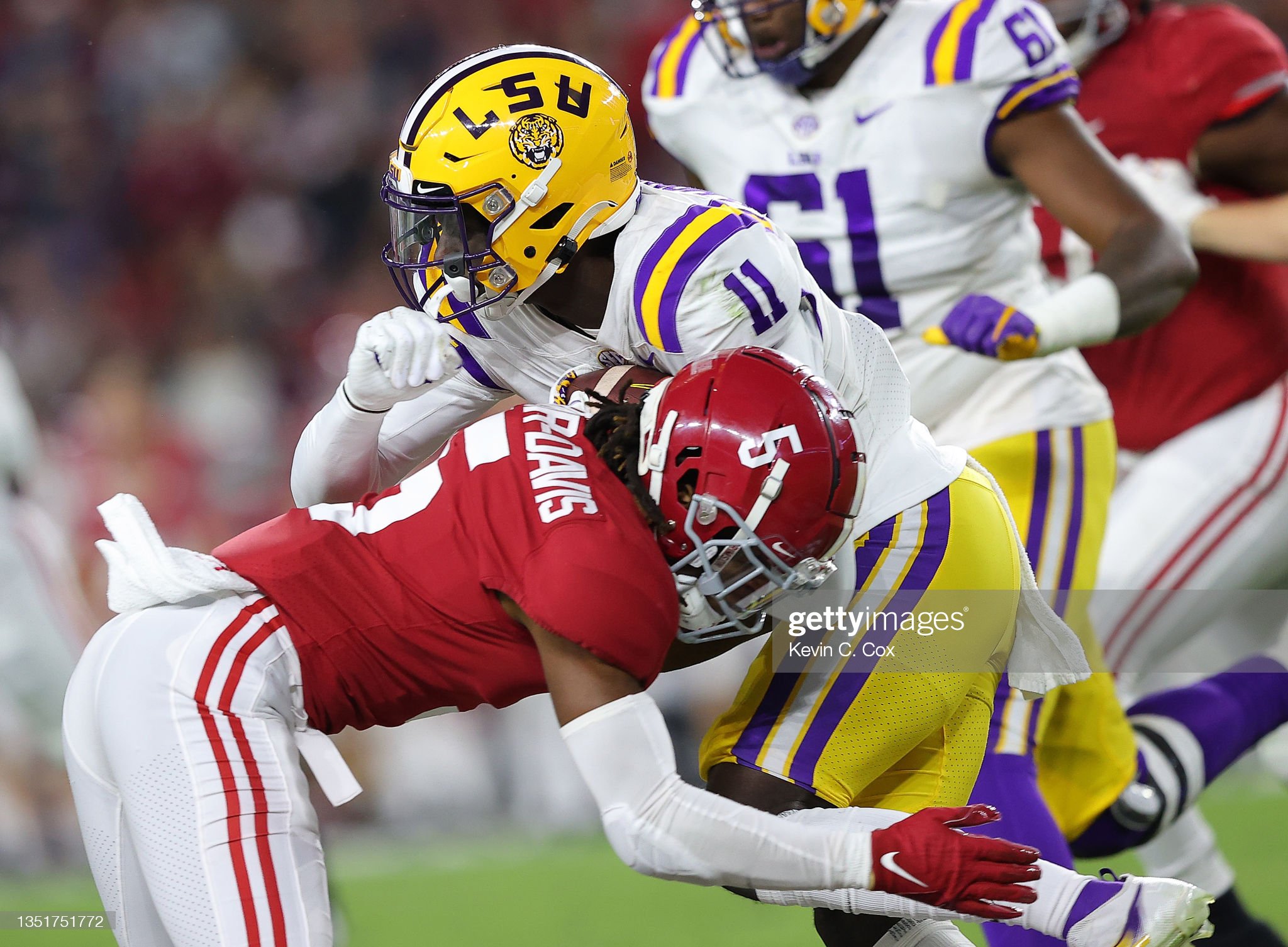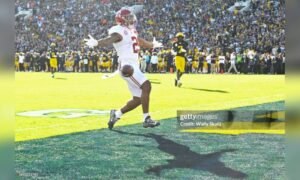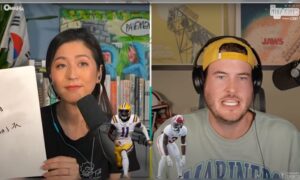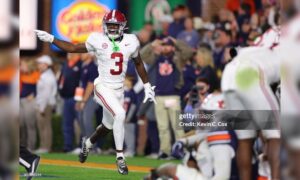From now until the 2022 NFL Draft takes place, we hope to scout and create profiles for as many prospects as possible, examining their strengths, weaknesses, and what they can bring to an NFL franchise. These players could be potential top 10 picks, all the way down to Day 3 selections and priority undrafted free agents. Today, I’ll be profiling an edge rusher that possesses immense physical tools and high upside as a potential game wrecker in the league, but a recent injury has the potential to submarine his draft stock.
#5 Jalyn Armour-Davis, CB, Alabama — 6005, 197 lbs.
Combine Invite
Measurements
| Player | Ht/Wt | Hand Size | Arm Length | Wingspan |
| Jaylon Armour-Davis | 6005/197 | 9 1/4″ | 30 7/8″ | 74 1/2″ |
| 40-Yard Dash | 10-Yard Dash | Short Shuttle | 3-Cone | |
| 4.39 | 1.54 | 4.45 | N/A | |
| Broad Jump | Vertical | Bench Press | ||
| 10’2” | 34.3 | 14 |
The Good
— Enters the NFL with plenty of experience both in the slot and on the boundary, giving him valuable inside/outside versatility
— Does a good job of matching the opposing receivers tempo in his pedal to stay on top of the route in off man coverage
— Locates and plays the football well when playing from in phase
— Violent hands while playing the pocket at the catch point
— Does a great job of staying square at the line of scrimmage and closing to the receivers chest downfield in press coverage
— Possesses solid hip mobility, allows him to transition effectively into his crossover run
— Has some solid tape working as a blitzer off the edge
— Has the speed to recover and carry receivers vertically even when beaten at the line of scrimmage
— Does a good job of navigating past oncoming blockers in space with speed and agility
— Effective as an open field tackler
— Strong punch allows him to force receivers to play through contact in press coverage
The Bad
— Struggles when playing the catch point downfield when unable to locate the football, most notably on back shoulder balls
— Consistently struggles disengaging from stalk blocks, by far his biggest weakness as a player
— Will struggle at times to combat subtle push offs at the top of routes from wide receivers on comebacks and stop routes
— Hesitates at times coming out of his breaks, particularly when he has opened into a crossover run
— Lacks effort at times pursuing the ball carrier when away from the football
— Will occasionally open the gate early in press coverage, allowing receivers to cross his face coming back inside
Bio
— 36 tackles 1 TFL 3 INTs 9 PDs
— 2021: 32 tackles 1 TFL 3 INTs 7 PDs
— 2021 All-SEC 2nd Team
— Was first named a starter at the cornerback position in fall camp of this past season, primarily saw special teams and sub package work in 2019 and 2020
— Redshirted in 2018 following a knee injury which kept him out for the entire season
Tape Breakdown
While the debate for who is the true holder of the “DBU” mantra will never be fully settled, alongside Washington and LSU, Alabama is consistently among the top programs in the nation at producing dratable talent in the secondary. In this year’s draft crop, Alabama fields two prospects likely to hear their name called in April, those being Josh Jobe, who was recently profiled by our Alex Kozora, and the topic of today’s profile, Jalyn Armour-Davis. As a first year starter this fall, Armour-Davis finished All-SEC 2nd team, tallying 32 tackles, a tackle for a loss, three interceptions, and seven passes defended, showcasing a nice combination of athleticism and understanding of coverage schematics.
Exiting college with experience both in the slot and on the boundary while guarding SEC competition, Armour-Davis figures to enter the NFL ready to compete for sub-package snaps during his rookie campaign. While his athleticism allows him to compete and play the catch point in man coverage, Armour-Davis’s presence in zone coverage, where he is consistently in the right spots and able to key the quarterback, is already at a very high level. While the single year of starter level collegiate experience may be a red flag for some teams in their evaluation, he was part of a loaded secondary which featured Trevon Diggs and Pat Surtain II in his first season, with Surtain II on the roster for his first two seasons.
Armour-Davis’s comfortability in his backpedal and seamless transitions to open and carry receivers downfield make him particularly effective in off-man coverage, which is traditionally his go-to approach when aligned in the slot. Below, Davis aligns at seven yards depth with outside leverage, forcing the defender inside to his post safety help in the Cover 1 scheme. After maintaining his cushion with a solid tempo pedal, Armour-Davis opens toward the sideline, maintaining vision on the quarterback and high pointing the football to pick off an overthrown curl route.
As is traditionally the case with Nick Saban coached cornerbacks, Armour-Davis showed plenty of ability to blanket receivers in press man coverage in his lone season as a starter. Below, in a matchup against Tennessee, Armour-Davis aligns in press coverage to the field, engaging a strong punch with his inside arm before matching the inside release and replacing it with his outside arm.
As the receiver attempts a “throw by”, Armour-Davis is able to square up and maintain contact, maintaining a two hand jam until the receiver is eventually able to break toward the sideline 10 yards downfield. Armour-Davis ability to disrupt the timing between the quarterback and receiver here allows the pass rush to force an errant throw, as well as making the receiver prepare for contact on later reps, slowing his releases as the game continues.
Armour-Davis did a great job of understanding situational football (possession down/redzone/2 minute drill ect.) at Alabama. Below, aligned in off man coverage to the trips set, Armour-Davis aligns at six yards depth with inside leverage, understanding that the outside receiver in trips will conventionally run an in-breaking route and the fade to the field the toughest throw for the quarterback to make.
At the snap, Armour-Davis patiently gives ground, maintaining his inside leverage, before triggering downhill as the receiver declares on the slant route, closing to the top shoulder, and leaving his feet to violently play through the hands. While ideally you would like to see Armour-Davis stay more square retreating toward the goal line, his great hip mobility allows him to transition quickly to stay in phase and break up the pass.
As I previously mentioned, Armour-Davis maintains a high level understanding of his assignments in zone coverage, which consistently puts him in the right place to capitalize on tipped balls and overthrows. Below, working as a flat zone defender to the field in a split field coverage, Armour-Davis aligns with outside leverage at six yards depth, re-routing the point man and gaining depth before zoning off to the flat.
As the ball is thrown, Armour-Davis drives an errant throw intended for a slant, securing an easy interception before turning on the jets and working toward the sideline for a 47 yard return. Whereas many cornerbacks allow their desire to reroute receivers to draw them out of inside and away from their flat zone, Armour-Davis trust of his teammates and the greater scheme allows him to zone off and stay in position to capitalize on the mistimed throw.
While watching college cornerbacks, it can be as important to watch for reps that showcase their raw, physical tools and movement skills, as it is to watch those in which they play the catch point. On the rep below, against Tennessee, he aligns at six yards depth in the boundary before bailing at the snap in a deep ⅓ Cover 3 zone assignment, working slowly to gain depth before seeing the #1 receiver stop on a hitch route.
As #1 eliminates, Armour-Davis works to squeeze #2 up the seam, transitioning from his crossover run into a full spring and cutting off the receivers path to the football, forcing the incompletion. The speed at which he is able to close ground and get on top of the seam is without a doubt top end for the position, and should help him become an extremely ineffective zone defender at the next level.
When able to stay clean and navigate past blockers in space, Armour-Davis has proven to be extremely willing and effective as both a box defender in the run game and as an open field tackler. Below, aligned as the overhang defender to the field against LSU’s heavy personnel tight set, he slowly gains depth before identifying the reverse play and planting to trigger downhill.
Upon triggering, he beats the oncoming puller to the edge, forcing the runner to cut back inside before disengaging the off balance blocker to the inside and shooting low to execute textbook hawk/roll tackle. While Armour-Davis is merely responsible for boxing the puller and sending the run back inside, his ability to disengage and make the tackle holds what could have been an explosive run to merely five yards.
Similar to his work in the run game, when able to stay clean and navigate past blockers in space, Armour-Davis’s ability to trigger quickly and tackle effectively at the point of contact make him a solid screen game defender. Below, aligned at five yards depth to a bunch stack, he slowly reads the quarterback before seeing Matt Corral pull the pin, and triggering downhill, working outside in to maintain his outside leverage.
At the point of contact, Armour-Davis comes to balance and aims low, wrapping up the ball carrier and stopping his progress to allow his teammates to arrive for the gang tackle. His biggest strength in defending the run and screen game is his ability to recognize the play, trigger quickly, and meet the ball carrier before they can turn and get their momentum moving downhill.
While he will occasionally hesitate out of breaks and has trouble disengaging from blockers once they are able to get into his frame, Armour-Davis biggest struggle at the collegiate level was undeniably his inability to defend back shoulder throws. When beaten off the line of scrimmage, he simply was too often unable to stay patient and play the receivers hands as they slowed their tempo, rather, he was often unable to come to balance and play the pocket from a trailing position.
At the NFL level, where receivers are far better at making contested catches and quarterbacks can place back shoulder balls into perfect windows, Armour-Davis will need to learn to stay patient and trust his technique to contest the pocket. Given that he has the traits, there is no reason to think he couldn’t continue to improve in this facet of his game with further coaching at the next level.
Conclusion
Overall, Jalyn Armour-Davis is a high end athlete with great top end speed and change of direction ability, along with great understanding of coverage schematics after playing under Nick Saban at Alabama. Moreover, his positional and schematic versatility, playing a variety of assignments and techniques from both the slot and the boundary, provides him with value to provide depth at multiple positions and compete for a sub-package role early in his career.
Immediately, Armour-Davis ability to excel in situational football scenarios could immediately add value to an NFL defense, while his ability in zone coverage could help make a defense sound in their scheme and generate turnovers at an increased rate. Moving toward the NFL I’d say that Armour-Davis’s ceiling is similar to current Cincinnati Bengal Chidobe Awuzie, both in terms of relative athleticism and frame as well as the quick trigger ability to become a disruptive force in the defending the run and screen game at the next level.
If drafted in Pittsburgh, Armour-Davis could immediately compete with Tre Norwood for snaps on the inside in the teams Dime packages, while also providing help on special teams, where he gained plenty of experience over his first two seasons at Alabama. Eventually, he could progress toward providing similar versatility to current Steeler, Cameron Sutton, in his ability to play effectively both on the boundary and slot, both of out press and off coverage alignments. If Armour-Davis is still on the board when Pittsburgh picks on Day 3, he would undeniably be an intriguing option to add depth and special teams value to an already solid cornerback group.
Projection: Late Day Two/Early Day Three
Depot Draft Grade: 7.6-Potential Starter/Good Backup(3rd round)
Games Watched: vs Tennessee(2021), vs Ole Miss(2021), vs LSU(2021), at Florida(2021)








